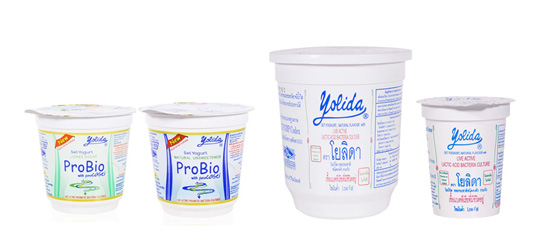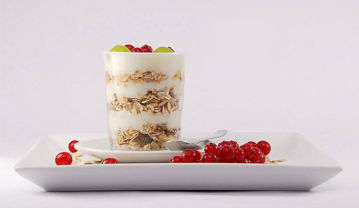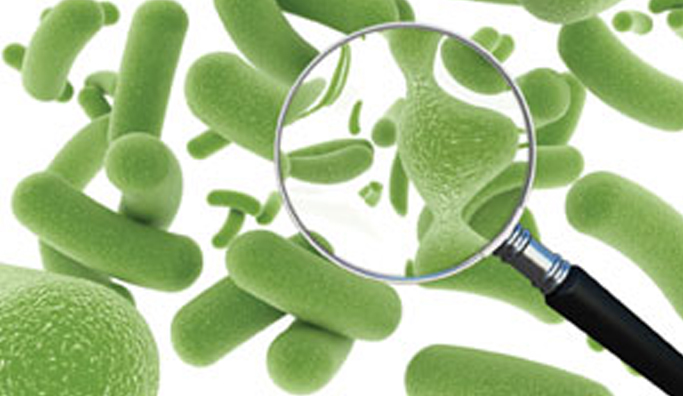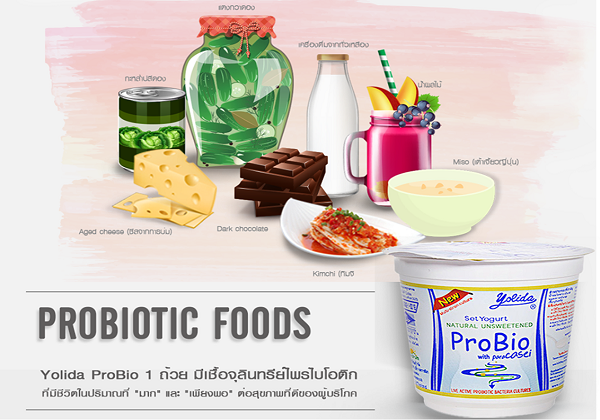WHY YOGURT IS GOOD FOR YOU
Why Yogurt is GOOD for You: The Key is in Your Intestinal Tract
Bacteria in Your Intestinal TractIt is in your intestinal tract, particularly the latter portion of your small intestine and most of the large intestine, or colon, is where there is a vast flora of bacterial microbes that are active. There are hundreds of species of bacteria present in this part of the human gut and may total in the trillions of microbes. The accumulation and diversity of these bacteria depends largely on what you eat, and in what proportion, and on how much food you take in.


The “Good” and the “Bad””
It is a well-known fact that the bacteria in the human gut comprise of both “bad”, or harmful bacteria; and “good” or beneficial bacteria. Common bad bacteria include some species of bacteroides, which have been linked to various types of infections when they escape the intestine wall, and to colon cancer. Common “good” bacteria includes various types of lactic acid bacteria such as lactobacillus and bifidobacterium, which are generally abundant in healthy individuals, especially in young children. Through various processes, such as chemical metabolises and fermentation, these bacteria become absorbed into our bodies and act on our health system in many ways, including both beneficial and harmful.

Some of the benefits produced by the “good” bacteria include the production of essential fatty-acids, some types of vitamins, and molecules that assist in functions of the brain. Other types of “good” bacteria have anti-body forming properties that can ward off and prevent the growth of some types of “bad” bacteria. At the same time however, there is a growing body of research that links various groups of “bad” bacteria to pathogens causing infections, inflammations, and other harmful invasions, and that are linked to many common diseases, including those of the skin, lungs, joints and muscle tissue, and others.
While “bad” bacteria are ever present, both on the outside and the inside of our bodies, an important aspect of maintaining good health is to keep them from multiplying excessively and becoming the dominant form of bacteria in our gut. If “bad” bacteria are dominant they may gain greater opportunity to become absorbed into our bloodstream and organs and cause disease. For good gastro-intestinal health, the prevention of excessive proliferation of “bad” bacteria is essential. Keeping “bad” bacteria growth in check can be accomplished by ensuring that the flora of “good” bacteria in our gut are dominant in proportion to the “bad” bacteria. A large body of common research has shown that, in addition to anti-body forming properties, “good” bacteria accomplish this because they tend to promote a slightly acidic environment in the gut. Since many types of “bad” bacteria do not survive well in an acidic environment, the presence of “good” bacteria in sufficient numbers helps inhibit the proliferation of pathogenic bacteria.

It is a well-known fact that the bacteria in the human gut comprise of both “bad”, or harmful bacteria; and “good” or beneficial bacteria. Common bad bacteria include some species of bacteroides, which have been linked to various types of infections when they escape the intestine wall, and to colon cancer. Common “good” bacteria includes various types of lactic acid bacteria such as lactobacillus and bifidobacterium, which are generally abundant in healthy individuals, especially in young children. Through various processes, such as chemical metabolises and fermentation, these bacteria become absorbed into our bodies and act on our health system in many ways, including both beneficial and harmful.

Some of the benefits produced by the “good” bacteria include the production of essential fatty-acids, some types of vitamins, and molecules that assist in functions of the brain. Other types of “good” bacteria have anti-body forming properties that can ward off and prevent the growth of some types of “bad” bacteria. At the same time however, there is a growing body of research that links various groups of “bad” bacteria to pathogens causing infections, inflammations, and other harmful invasions, and that are linked to many common diseases, including those of the skin, lungs, joints and muscle tissue, and others.
While “bad” bacteria are ever present, both on the outside and the inside of our bodies, an important aspect of maintaining good health is to keep them from multiplying excessively and becoming the dominant form of bacteria in our gut. If “bad” bacteria are dominant they may gain greater opportunity to become absorbed into our bloodstream and organs and cause disease. For good gastro-intestinal health, the prevention of excessive proliferation of “bad” bacteria is essential. Keeping “bad” bacteria growth in check can be accomplished by ensuring that the flora of “good” bacteria in our gut are dominant in proportion to the “bad” bacteria. A large body of common research has shown that, in addition to anti-body forming properties, “good” bacteria accomplish this because they tend to promote a slightly acidic environment in the gut. Since many types of “bad” bacteria do not survive well in an acidic environment, the presence of “good” bacteria in sufficient numbers helps inhibit the proliferation of pathogenic bacteria.

Yogurt in Your Diet
The important matter here is thus to ensure that your diet includes foods with sufficient means to promote the proliferation of “good” bacteria in order to maintain a healthy, slightly acidic gut environment, and therefore able to keep the “bad” bacteria in check. A balanced diet that encompasses all the five main food groups, and that is high in fibre, is the best starting point. Unfortunately, the diet for many people is not that well balanced. Most diets in our modern urbanized society tend to be high in fats, meat protein, sugars and other carbohydrates. All these foods are low in fibre and promote an alkaline environment in the human gut, where the proliferation of pathogenic bacteria can take place.foods are low in fibre and promote an alkaline environment in the human gut, where the proliferation of pathogenic bacteria can take place.
The important matter here is thus to ensure that your diet includes foods with sufficient means to promote the proliferation of “good” bacteria in order to maintain a healthy, slightly acidic gut environment, and therefore able to keep the “bad” bacteria in check. A balanced diet that encompasses all the five main food groups, and that is high in fibre, is the best starting point. Unfortunately, the diet for many people is not that well balanced. Most diets in our modern urbanized society tend to be high in fats, meat protein, sugars and other carbohydrates. All these foods are low in fibre and promote an alkaline environment in the human gut, where the proliferation of pathogenic bacteria can take place.foods are low in fibre and promote an alkaline environment in the human gut, where the proliferation of pathogenic bacteria can take place.


As a way to help rebalance this situation, the right type of good quality yogurt can play a very helpful role. Yogurt is generally slightly acidic and comprises of lactic acid bacteria, which is a good combination to help promote the growth of “good” bacteria and ward off the “bad” bacteria in your gastro-intestinal tract.
At the same time, it must be understood that not all yogurt is the same, and its effectiveness in helping to prevent the proliferation of harmful bacteria in the gut depends largely on the quantity and on the “active” nature of the lactic acid bacteria in it. For yogurt to have a strong positive role on the microbe flora environment of the gut it is important for the lactic acid bacteria in it to be both LIVE and ACTIVE, and also be present in a sufficient quantity.
At the same time, it must be understood that not all yogurt is the same, and its effectiveness in helping to prevent the proliferation of harmful bacteria in the gut depends largely on the quantity and on the “active” nature of the lactic acid bacteria in it. For yogurt to have a strong positive role on the microbe flora environment of the gut it is important for the lactic acid bacteria in it to be both LIVE and ACTIVE, and also be present in a sufficient quantity.

YOLIDA YOGURT
This is where YOLIDA yogurt is your best choice.Some types of yogurt are produced using the “stirred” method. Under this process, the bacterial starter culture is added when the milk is still in the yogurt processing vat. Then the milk is allowed to ferment in the vat. After fermentation it is re-stirred and usually reheated prior to filling into the cup. This re-stirring and reheating creates a soft stirred texture and also may tend to kill off many of the good bacteria that had earlier been added and allowed to ferment. By the time the yogurt is in the cup, in its stirred form, a low proportion of the “good” lactic acid bacteria may remain alive. Most of this type of yogurt also has a very high amount of sugar (up to 8% for some brands!) and various artificial coloring and flavors, which cannot be considered “good” for your gut.
In contrast, all YOLIDA yogurt is pure and natural, and is made in a special process whereby “good” LIVE and ACTIVE lactic bacteria culture is added to the milk only after it has been pasteurized. It is then immediately and hygienically filled into the cup, and the curd is “set” by incubating directly in the cup. There is no reheating or re-stirring of the milk after the bacteria culture has been added. This process preserves the LIVE and ACTIVE nature of the bacterial starter culture, which then becomes fermented in the yogurt.
In addition, all YOLIDA yogurt has been tested and determined to contain a very high concentration of LIVE and ACTIVE lactic acid bacteria. When consumed regularly, these bacteria, as supplied by YOLIDA, can have a positive gastro-intestinal health benefit for all our customers.





